 W
WAmphisbaena alba, also known as the red worm lizard or less commonly as the white or white-bellied worm lizard, is a species of amphisbaenian in the reptilian order Squamata. Despite the large geographic range that this species covers, little is known about its ecology due to its secretive habits. A. alba has a diverse diet ranging from plant material to small vertebrates. Numerically, beetles, ants, and spiders compose the majority of their diet; however, ants, insect larvae, and beetles are ingested to satisfy a larger volume.
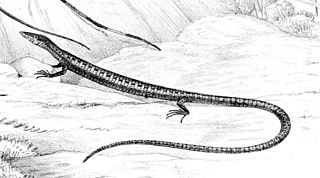 W
WAnadia ocellata, commonly known as the ocellated anadia , is a species of lizard endemic to the Americas.
 W
WAnolis biporcatus, also known as the neotropical green anole or giant green anole, is a species of anole. It is found in forests, both disturbed and undisturbed, in Mexico, Central America, Colombia and Venezuela. More southern populations, in southwestern Colombia and western Ecuador, were recognized as a separate species, A. parvauritus, in 2017.
 W
WAnolis kemptoni, or Kempton's anole, is a species of lizard in the family Dactyloidae. The species is native to Central America.
 W
WThe big-scaled blind snake is a species of snake in the family Leptotyphlopidae. The species is endemic to southern Central America and northern South America.
 W
WBoa imperator is a large, heavy-bodied, nonvenomous species of snake, of the boa genus, that is commonly kept in captivity. Boa imperator is part of the family Boidae and is found in Mexico, Central America and South America west of the Andes Mountains. It is commonly called the northern boa, Colombian boa and common northern boa and is frequently and erroneously referred to as the red-tailed boa or Colombian red-tailed boa, especially in the pet trade.
 W
WBothriechis lateralis is a venomous pit viper species found in the mountains of Costa Rica and western Panama. No subspecies are currently recognized.
 W
WBothriechis nigroviridis is a venomous pit viper species found in the mountains of Costa Rica and Panama. No subspecies are currently recognized. The specific name is derived from the Latin niger (black) and viridis (green) in reference to its distinctive color pattern.
 W
WBothrops asper is a highly venomous pit viper species, ranging in distribution from southern Mexico to northern South America. It is found in a wide range of lowland habitats, often near human habitations. Because of its proximity to human habitations and its defensive temperament, it is more dangerous to people than many other snakes. This species is the main cause of snakebite incidents within its range. No subspecies are currently recognized.
 W
WBothrops atrox — also known as the common lancehead, fer-de-lance, barba amarilla and mapepire balsain — is a highly venomous pit viper species found in the tropical lowlands of northern South America east of the Andes. No subspecies are currently recognized.
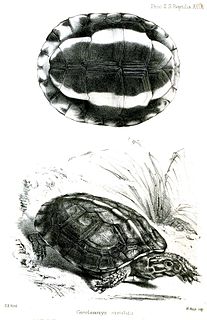 W
WThe brown wood turtle or brown land turtle is a species of turtle in the family Geoemydidae. The species is endemic to Central America and northern South America.
 W
WThe spectacled caiman, also known as the white caiman, common caiman, and speckled caiman, is a crocodilian in the family Alligatoridae. It is brownish-, greenish-, or yellowish-gray colored and has a spectacle-like ridge between its eyes, which is where its common name come from. It grows to a length of 1.4–2.5 metres (4.6–8.2 ft) and a weight of 7–40 kilograms (15–88 lb), with males being both longer and heavier than females. Its diet varies seasonally, commonly consisting of crabs, fish, mammals, and snails. Breeding occurs from May to August and 14–40 eggs are laid in July and August. This crocodilian has a large range and population, native to much of Latin American and introduced to the United States.
 W
WThe Colombian wood turtle is one of nine species of turtle belonging to the genus Rhinoclemmys of the family Geoemydidae. It is found in Colombia, Ecuador, and Panama.
 W
WThe common basilisk is a species of lizard in the family Corytophanidae. The species is endemic to Central America and South America, where it is found near rivers and streams in rainforests. It is also known as the Jesus Christ lizard, Jesus lizard, South American Jesus lizard, or lagarto de Jesus Cristo for its ability to run on the surface of water.
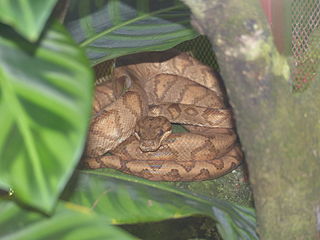 W
WCorallus annulatus is a non-venomous boa species found in Central and South America. Three subspecies are currently recognized, including the nominate subspecies described here.Common names: ringed tree boa, annulated tree boa, northern annulated tree boa.
 W
WCorallus ruschenbergerii is a nonvenomous boa species endemic to lower Central America and northern South America. No subspecies are currently recognized.
 W
WThe American crocodile is a species of crocodilian found in the Neotropics. It is the most widespread of the four extant species of crocodiles from the Americas, with populations present from South Florida and the coasts of Mexico to as far south as Peru and Venezuela.
 W
WCtenosaura similis, commonly known as the black spiny-tailed iguana, black iguana, or black ctenosaur, is a lizard native to Mexico and Central America that has been introduced to the United States in the state of Florida. It is the largest species in the genus Ctenosaura and has been recorded as the fastest-running species of lizard.
 W
WDendrophidion percarinatum, commonly known as the South American forest racer, is a snake of the colubrid family.
 W
WMorunasaurus groi, known commonly as Gro's manticore, Dunn's spinytail iguana, or Dunn's spinytail lizard, is a species of lizard in the family Hoplocercidae. The species is endemic to northwestern South America and Panama.
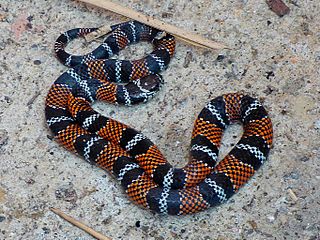 W
WErythrolamprus bizona, commonly known as the double-banded false coral snake, is a species of colubrid snake, which is endemic to northern South America and Central America.
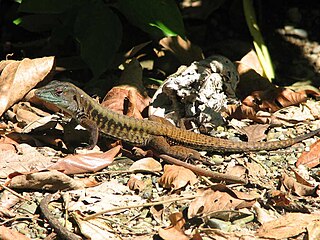 W
WHolcosus leptophrys, the delicate ameiva or delicate whiptail, is a species of whiptail lizard found in Panama and Costa Rica to Colombia.
 W
WImantodes cenchoa is a species of rear-fanged colubrid snake distributed in Mexico, Central America, and South America.
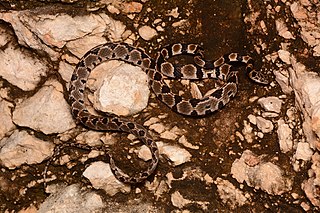 W
WImantodes gemmistratus is a snake species in the colubrid family, found from Mexico, through Central America and Colombia.
 W
WLachesis stenophrys is a venomous pit viper species endemic to Central America. The specific name, stenophrys, is derived from the Greek words stenos, meaning "narrow", and ophrys, meaning "brow" or "eyebrow". No subspecies are currently recognized.
 W
WLampropeltis micropholis, commonly known as the Ecuadorian milk snake, is a species of milk snake.
 W
WLoxopholis southi, also known commonly as the northern spectacled lizard and the southern leposoma, is a species of lizard in the family Gymnophthalmidae. The species is native to southeastern Central America and northwestern South America. There are two recognized subspecies.
 W
WThe Meso-American slider is a species of turtle belonging to the family Emydidae. The species is distributed from Mexico to Colombia.
 W
WMicrurus mipartitus is a species of coral snake in the family Elapidae. It is found in South and Central America. The redtail coral snake is common in agricultural areas in Colombia. Its highly neurotoxic venom is known to cause seizures in its prey by activating nerve proteins responsible for seizures within it.
 W
WMicrurus nigrocinctus, commonly known as the Central American coral snake, is a species of a highly venomous snake in the family Elapidae. The species is endemic to Latin America from southern Mexico, Central America, to north Colombia. There are six recognized subspecies, including the nominate subspecies described here.
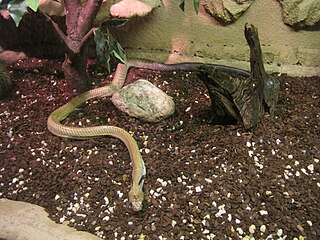 W
WThe Middle American indigo snake, also known commonly as the blacktail cribo, is a species of large, nonvenomous, snake in the family Colubridae. The species is endemic to the southwestern United States, Mexico, Central America, and northern South America. In addition to the nominotypical subspecies, it has four other recognized subspecies, including D. m. erebennus commonly known as the Texas indigo snake.
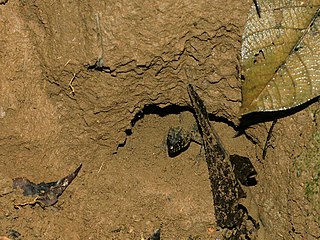 W
WThe yellow-spotted tropical night lizard or yellow-spotted night lizard is a species of night lizard. It is distributed from central Mexico through the Central America south to Panama. It includes four subspecies:Lepidophyma flavimaculatum flavimaculatum Lepidophyma flavimaculatum ophiophthalmum Lepidophyma flavimaculatum tehuanae Lepidophyma flavimaculatum tenebrarum
 W
WNinia atrata, known commonly as Hallowell's coffee snake, Hallowell's earth snake, the red-nape snake, and the South American coffee snake, is a species of small terrestrial snake in the family Colubridae. The species is native to southern Central America and northern South America.
 W
WOxybelis fulgidus, commonly known as the green vine snake or the flatbread snake, is a species of long, slender, arboreal colubrid snake, which is endemic to Central America and northern South America.
 W
WOxyrhopus petolarius, commonly known as the false coral, is a species of snake in the family Colubridae. The species is endemic to South America. There are three recognized subspecies.
 W
WPhrynonax poecilonotus is a species of nonvenomous snake in the family Colubridae. The species is endemic to the New World.
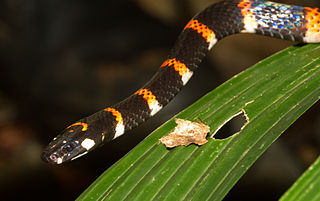 W
WPliocercus euryzonus, commonly known as Cope's false coral snake, is a species of snake in the subfamily Dipsadinae of the family Colubridae. The species is indigenous to southeastern Central America and northwestern South America. There are two recognized subspecies.
 W
WPolychrus gutturosus, also known as Berthold's bush anole or monkey tailed anole, is a species of lizard found in tropical Central and South America. It is sometimes referred to as a "forest iguana". It lives in forests and jungles from Honduras to Ecuador. It can reach up to 70 cm (2.3 ft) in total length, including its very long tail, and males are considerably smaller than females. This insectivorous lizard is a climbing species that can often be seen holding onto branches. It can even hold on with its hind legs, though it moves slowly that way.
 W
WPorthidium lansbergii is a species of venomous snake, a pitviper in the family Viperidae. The species is endemic to Central and South America. Four subspecies are recognized, including the nominate subspecies described here.
 W
WPorthidium nasutum is a venomous pitviper species found in Mexico, Central America and northern South America. No subspecies are currently recognized.
 W
WPseudoboa neuwiedii, commonly known as the ratonel or ratonera (mouse-eater), is a species of snake in the family Colubridae. The species is endemic to northern South America.
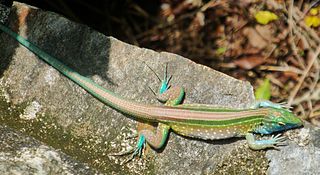 W
WThe rainbow whiptail is a species of lizard found in Central America, the Caribbean, and northern South America. It has also been introduced in Florida and has established populations there. A rainbow whiptail grows up to approximately 12 inches (30.5 cm).
 W
WRhinobothryum bovallii, commonly known as the coral mimic snake or the false tree coral, is a species of snake in the family Colubridae. The species is endemic to Central America and northwestern South America.
 W
WScaphiodontophis venustissimus, commonly known as the common neckband snake, is a snake of the colubrid family.
 W
WSibon longifrenis is a species of snake in the family Colubridae. It is found in Panama, Costa Rica, Honduras and Nicaragua.
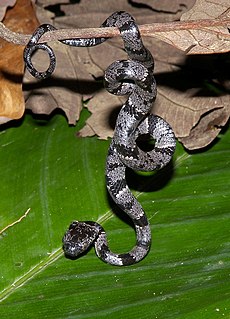 W
WSibon nebulatus, commonly known as the clouded snake, is a species of small, slender arboreal snake which is found in southern Mexico, Central America, northern South America, Isla Margarita, and Trinidad and Tobago.
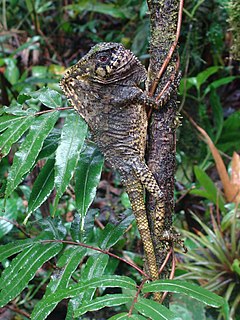 W
WThe smooth helmeted iguana, sometimes also known as helmeted iguana, helmeted basilisk, elegant helmeted lizard, etc., is a species of New World lizard in the family Corytophanidae.
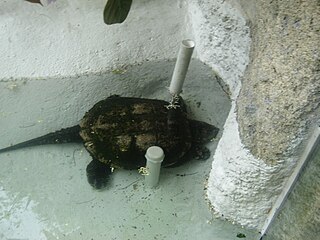 W
WThe South American snapping turtle is a species of turtle in the family Chelydridae. This species, which is endemic to Central and northwestern South America, was previously considered a subspecies of Chelydra serpentina. Its restricted range in South America reflects its recent arrival there as part of the Great American Interchange.
 W
WSphaerodactylus macrolepis, also known as the big-scaled least gecko, big-scaled dwarf gecko, or cotton ginner, is a gecko distributed in the United States Virgin Islands and the British Virgin Islands and Culebra, Puerto Rico in the Caribbean. It is one of over 100 species in the genus Sphaerodactylus.
 W
WSpilotes pullatus, commonly known as the caninana, chicken snake, yellow rat snake, or serpiente tigre, is a species of large nonvenomous colubrid snake endemic to warmer parts of the Americas.
 W
WTantilla melanocephala, commonly known as the black-headed snake, is a species of small colubrid snake endemic to Central America and South America.
 W
WTrachyboa boulengeri, commonly known as the northern eyelash boa, is a species of nonvenomous snake in the family Tropidophiidae. The species is endemic to Central America.
 W
WUngaliophis panamensis, or the Panamanian dwarf boa, is a species of snake in the family Tropidophiidae. It is native to Nicaragua, Costa Rica, Panama, and Colombia.
 W
WThe white-lipped mud turtle is a species of mud turtle in the family Kinosternidae. The species is endemic to Central America and northwestern South America.
 W
WGonatodes albogularis, which has been called a number of vernacular names in English, is a smallish species of gecko found in warm parts of Central and South America, Cuba, Hispaniola and Jamaica. It is sexually dimorphic: the male is colourful, while the female is a more drab grey. The fingers do not have lamellar pads for climbing smooth surfaces like many other geckos but instead have normal claws like most lizards. At one time the species had a breeding population in southern Florida, especially Key West, but this population appears to have died out by the early 1990s.